Crosley Tube Radios
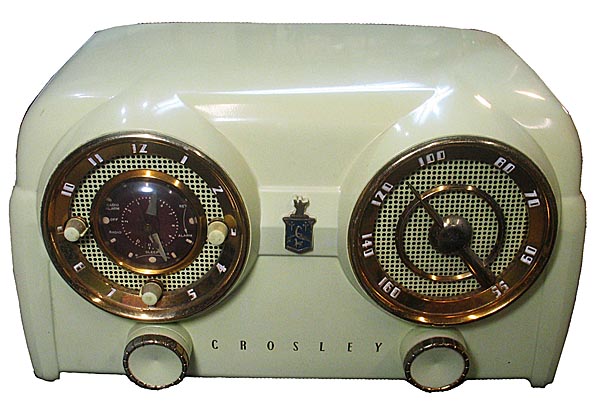
1952 Crosley D25CE Clock Radio
Crosley "Dashboard" radios are iconic symbols of mid-Twentieth Century industrial styling. Intended to resemble the dashboards of early 1950's automobiles, Crosley produced several styles of their "Dashboard" radios. The model D-25 and its variants are perhaps the most attractive, and the only version that included a clock. This radio is quite pristine, with no cracks or chips, and just a bit of wear on the brass clock surround from use.
This is a D-25CE, the model designation for the chartreuse cabinet. Other colors were produced as well. The radio itself is a basic five tube All-American design with a loop antenna embedded on the rear cover. This particular radio is quite sensistive despite not having an RF amp. The audio qualilty is quite good. The radio was dead when I acquired it, but that was due to a bad output tube. I completely recapped the radio and replaced quite a few capacitors.
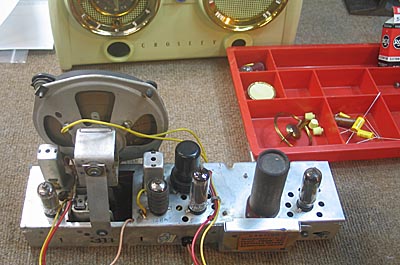 The Telechron clock runs accurately and silently. I gave it a drop or two of clock oil. The clock knob at the 9 o'clock position turns the radio on or off, or selects Radio Alarm mode, which allows setting the radio to turn on at a particular time. There's also a standard wake up alarm, and a sleep timer that lets the radio play for 60 minutes and then shut off. On the left end panel, there's a 120VAC outlet that can also be set to turn on an appliance, such as a coffee pot, at a predetermined time.
The Telechron clock runs accurately and silently. I gave it a drop or two of clock oil. The clock knob at the 9 o'clock position turns the radio on or off, or selects Radio Alarm mode, which allows setting the radio to turn on at a particular time. There's also a standard wake up alarm, and a sleep timer that lets the radio play for 60 minutes and then shut off. On the left end panel, there's a 120VAC outlet that can also be set to turn on an appliance, such as a coffee pot, at a predetermined time.
Finally, the radio features an RCA phono jack and switch on the rear panel. Most any audio device, such as an old RCA 45 record player attachment, CD player, or a smartphone, can be connected to the input with an appropriate adapter cabe and played through the radio.
Crosley began marketing radios in 1921 and went out of business in 1956. In the early 1990's, Modern Marketing Concepts in Louisville, KY, acquired rights to the Crosley brand. The revived Crosley Company began offering reproductions of various Crosley radios, along with several models of record players. Around 2000, a reproduction of the Crosely D-25 radio was produced. It included an FM band and built in cassette player. I don't know how good the reproduction Crosley radios are, but their record players have a poor reputation for quality and reliability; some may even damage vinyl records, according to consumer reviews.
Click Here to watch a You Tube video

1926 Crosley 5-50 Regenerataive/TRF Receiver
Crosley begain building radios in 1921. Introduced in 1926, the Crosley 5-50 boasted "One hand, one dial, one control." Most early radios of the era required tuning in a station with three different dials. The Crosley 5-50 ganged the three separate tuning capacitors so that tuning the single dial control turned all three capacitors in sync. Other features, with quaint names, included the Crescendon, an early type of volume control, and the Acuminators, essentially trimmer capacitors to fine tune reception of a broadcast station's signal.
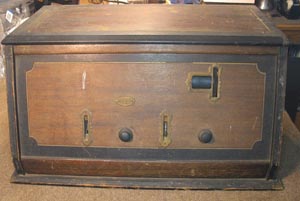 I acquired this set from a friend who brought three radios to me that had been in his family for generations: this Crosley, a 1938 Belknap 623, and a 1939 Silvertone 6421. I restored the latter two for him in exchange for the Crosley. I had never restored a TRF or regenerative receive, and knew very little about them. I did as much research as I could and got a lot of help from experts on the Antique Radio Forum. This is a battery operated, five tube radio, using four 201 tubes and a 171 for the output.
I acquired this set from a friend who brought three radios to me that had been in his family for generations: this Crosley, a 1938 Belknap 623, and a 1939 Silvertone 6421. I restored the latter two for him in exchange for the Crosley. I had never restored a TRF or regenerative receive, and knew very little about them. I did as much research as I could and got a lot of help from experts on the Antique Radio Forum. This is a battery operated, five tube radio, using four 201 tubes and a 171 for the output.
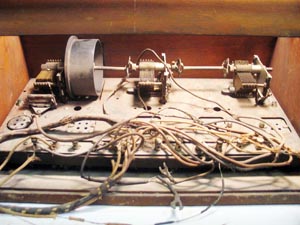 The cabinet was in pretty good condition overall. Some veneer was loose on the end panels, and one of the Acuminator toggles had broken off. Inside, the chassis was covered with dust and some minor rust in spots. Most of the couplers between the three tuning capacitors were broken, a common problem with this model. And both primaries of the two interstate audio transformers were open.
The cabinet was in pretty good condition overall. Some veneer was loose on the end panels, and one of the Acuminator toggles had broken off. Inside, the chassis was covered with dust and some minor rust in spots. Most of the couplers between the three tuning capacitors were broken, a common problem with this model. And both primaries of the two interstate audio transformers were open.
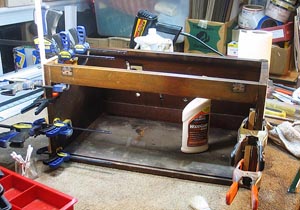 The first step in restoration was to repair the cabinet. I glued and clamped the loose veneer. I then stripped the old lacquer from the cabinet using Watco Furniture Refinisher, which removes the old lacquer, but doesn't remove the finish. I touched up the original finish with stain, and then applied several new coats of lacquer. I stripped all the old lacquer from the brass hardware using white vinegar, and applied new lacquer.
The first step in restoration was to repair the cabinet. I glued and clamped the loose veneer. I then stripped the old lacquer from the cabinet using Watco Furniture Refinisher, which removes the old lacquer, but doesn't remove the finish. I touched up the original finish with stain, and then applied several new coats of lacquer. I stripped all the old lacquer from the brass hardware using white vinegar, and applied new lacquer.
In the meantime, I removed all the components from the chassis. I used Naval Jelly to remove rust from the chassis, then gave it a coat of black paint. I also repaired the broken Acuminator switch. I ordered new cores for the two interstage audio transformers from Antique Electronics Supply, and installed them in the original housings. I cleaned the tuning capacitors and made new couplers from styrene plastic. I repaired the grid leak resistor, which was open. Finally, I installed a new dial scale on the dial drum. See potos below.
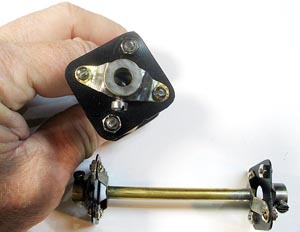


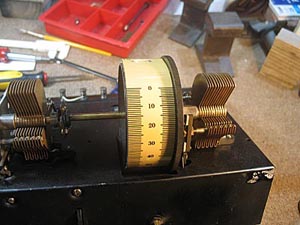
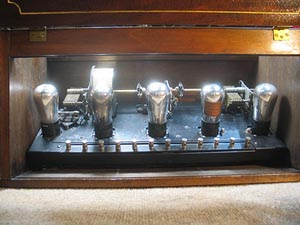
Here is a link to a thread I posted on the Antique Radio Forum which has more detailed information and photos of the various repairs I had to do, including repairing the broken switch, rebuilding the grid leak detector, and installing new cores in the audio transformers.
Crosley 5-50 Antique Radio Forum Thread
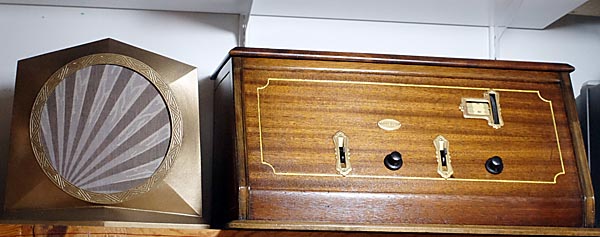 There were no tubes in the radio when I acquired it, so I purchased a set of tubes and installed them in the chassis, and reassembled the radio. Unfortunately, I haven't been able to test the radio to see if it works yet. The radio requires multiple voltages, and I will need to buy or construct a power supply for it. It requires an A voltage of 6 volts, B voltages of 45, 90, and 135 volts, and C voltages of -9 and -4.5 volts. I restored a 1929 Radiola 100B speaker some time ago, which will pair nicely with the Crosley.
There were no tubes in the radio when I acquired it, so I purchased a set of tubes and installed them in the chassis, and reassembled the radio. Unfortunately, I haven't been able to test the radio to see if it works yet. The radio requires multiple voltages, and I will need to buy or construct a power supply for it. It requires an A voltage of 6 volts, B voltages of 45, 90, and 135 volts, and C voltages of -9 and -4.5 volts. I restored a 1929 Radiola 100B speaker some time ago, which will pair nicely with the Crosley.
Crosley 5-50 Owner's Guide
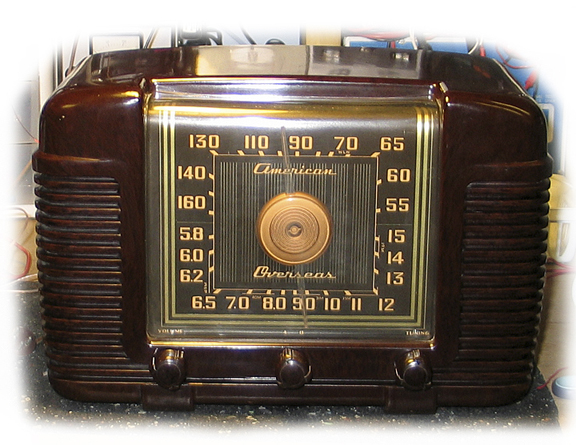
1946 Crosley 46FA "American Overseas" Farm Radio
This is a battery powered farm radio made for rural areas that might not have had electricity in the first half of the last century. The radio uses 1.5 volts for the filaments and 90 volts for the plate voltage. To power the radio, I built the reproduction battery shown in the photo, below right. As can be seen, the cabinet on this radio is in excellent condition, except for the missing back cover. Electronically, restoration consisted of recapping, replacing two bad tubes, repairing the broken battery plug, and repairing an open antenna coil. I think that it's a very handsome radio, and with a 50-foot long wire antenna attached, performance is pretty decent. The radio has a very solid feel to the controls, much like the knobs and switches on the older Volvos.

Click here to see and hear the Crosley radio play!



 The Telechron clock runs accurately and silently. I gave it a drop or two of clock oil. The clock knob at the 9 o'clock position turns the radio on or off, or selects Radio Alarm mode, which allows setting the radio to turn on at a particular time. There's also a standard wake up alarm, and a sleep timer that lets the radio play for 60 minutes and then shut off. On the left end panel, there's a 120VAC outlet that can also be set to turn on an appliance, such as a coffee pot, at a predetermined time.
The Telechron clock runs accurately and silently. I gave it a drop or two of clock oil. The clock knob at the 9 o'clock position turns the radio on or off, or selects Radio Alarm mode, which allows setting the radio to turn on at a particular time. There's also a standard wake up alarm, and a sleep timer that lets the radio play for 60 minutes and then shut off. On the left end panel, there's a 120VAC outlet that can also be set to turn on an appliance, such as a coffee pot, at a predetermined time.

 I acquired this set from a friend who brought three radios to me that had been in his family for generations: this Crosley, a 1938 Belknap 623, and a 1939 Silvertone 6421. I restored the latter two for him in exchange for the Crosley. I had never restored a TRF or regenerative receive, and knew very little about them. I did as much research as I could and got a lot of help from experts on the Antique Radio Forum. This is a battery operated, five tube radio, using four 201 tubes and a 171 for the output.
I acquired this set from a friend who brought three radios to me that had been in his family for generations: this Crosley, a 1938 Belknap 623, and a 1939 Silvertone 6421. I restored the latter two for him in exchange for the Crosley. I had never restored a TRF or regenerative receive, and knew very little about them. I did as much research as I could and got a lot of help from experts on the Antique Radio Forum. This is a battery operated, five tube radio, using four 201 tubes and a 171 for the output. The cabinet was in pretty good condition overall. Some veneer was loose on the end panels, and one of the Acuminator toggles had broken off. Inside, the chassis was covered with dust and some minor rust in spots. Most of the couplers between the three tuning capacitors were broken, a common problem with this model. And both primaries of the two interstate audio transformers were open.
The cabinet was in pretty good condition overall. Some veneer was loose on the end panels, and one of the Acuminator toggles had broken off. Inside, the chassis was covered with dust and some minor rust in spots. Most of the couplers between the three tuning capacitors were broken, a common problem with this model. And both primaries of the two interstate audio transformers were open. The first step in restoration was to repair the cabinet. I glued and clamped the loose veneer. I then stripped the old lacquer from the cabinet using Watco Furniture Refinisher, which removes the old lacquer, but doesn't remove the finish. I touched up the original finish with stain, and then applied several new coats of lacquer. I stripped all the old lacquer from the brass hardware using white vinegar, and applied new lacquer.
The first step in restoration was to repair the cabinet. I glued and clamped the loose veneer. I then stripped the old lacquer from the cabinet using Watco Furniture Refinisher, which removes the old lacquer, but doesn't remove the finish. I touched up the original finish with stain, and then applied several new coats of lacquer. I stripped all the old lacquer from the brass hardware using white vinegar, and applied new lacquer.




 There were no tubes in the radio when I acquired it, so I purchased a set of tubes and installed them in the chassis, and reassembled the radio. Unfortunately, I haven't been able to test the radio to see if it works yet. The radio requires multiple voltages, and I will need to buy or construct a power supply for it. It requires an A voltage of 6 volts, B voltages of 45, 90, and 135 volts, and C voltages of -9 and -4.5 volts. I restored a 1929 Radiola 100B speaker some time ago, which will pair nicely with the Crosley.
There were no tubes in the radio when I acquired it, so I purchased a set of tubes and installed them in the chassis, and reassembled the radio. Unfortunately, I haven't been able to test the radio to see if it works yet. The radio requires multiple voltages, and I will need to buy or construct a power supply for it. It requires an A voltage of 6 volts, B voltages of 45, 90, and 135 volts, and C voltages of -9 and -4.5 volts. I restored a 1929 Radiola 100B speaker some time ago, which will pair nicely with the Crosley.
